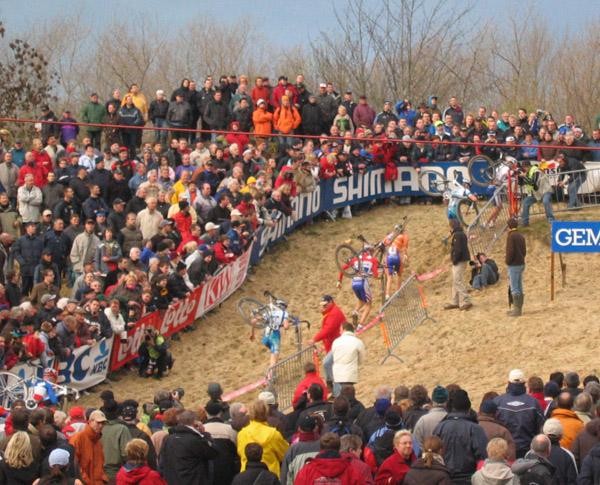Who got their tyres crossed?
Who came up with the idea of this slightly quirky sport we now know as cyclo-cross? And how did it...

Tales from the peloton, Saturday, November 9, 2006
Who got their tyres crossed?
Who came up with the idea of this slightly quirky sport we now know as cyclo-cross? And how did it reach the shores of America? Historian Les Woodland isn't quite sure himself, but has a pretty good idea.
A clever man, that Géo Lefèvre. Not only did he come up with the idea of the Tour de France, blurting it out for fear of having no ideas, he is also said to be the inventor of cyclo-cross. In the northern hemisphere right now, there are a lot of cold, wet, muddy people wishing he'd kept his mouth shut.
Now, it's not certain Lefèvre was the man who dunnit. But it's certainly true that in 1903, the year of the first Tour de France, he organised what was known then as a cross cyclo-pédèstre. It happened at Ville d'Avray, which happened to be also the town outside Paris where the first Tour finished because the capital wouldn't allow racing on its roads.
France was still licking its wounds after the Franco-Prussian war, when the Germans had got as far as Paris, so it was maybe not surprising that Lefèvre saw his race in military terms. He wrote: "Think about a cyclist in wartime. He can't use the main roads; he has to ride or walk across unmade roads and worm his way through the undergrowth and clamber across ditches. Think of that and you'll get the principle of the cross cyclo-pédèstre."
As I said, nobody is certain that Lefèvre was the first. It could have been a French soldier called Daniel Gousseau, who used to cycle through the woods while his general rode a horse beside him. He loved the exercise, the countryside and the peace of the woods after the regimented life of the army. He was so taken that he began to invite his friends to join him, although presumably without the general. Well, bikies are bikies and once the group had grown to a dozen or say they'd start holding tear-ups that quickly developed into races.
The latest race content, interviews, features, reviews and expert buying guides, direct to your inbox!
It may be that both stories are true. Gousseau was in a good position to write his own version of history because he became secretary of the French cycling federation. But he and Lefèvre belonged to the same club, where Lefèvre was one of the top riders. So perhaps one man inspired the races and the other wrote the rules. The dates look confusing because the first French championship was in 1902, which appears to be the year before Lefèvre came up with the image of a soldier cycling in war time. But remember that cyclo-cross is a winter sport and therefore spans the new year. Both 1902 and 1903 are part of the same season. A race in the spring of 1903 could still be said to have happened in 1902.
The first champion was F. Baeder. His first name has long vanished. Nobody took cyclo-cross as any more than fun and some doubtless regretted that it had its own championship. But then Octave "Curly" Lapize had a go. Lapize won the first stage of the Tour that crossed the Tourmalet, the highest pass in the Pyrénées. He said he owed his victory to the winter he'd spent mud-plugging. No greater endorsement was possible. And things went from strength to strength because Belgium's first cyclo-cross championship was won by Philippe Thijs, the first to win three Tours in a row.
The big international race was the Critérium International, held to the west of Paris in 1924. The course included a drop called the Trou de Diable - the Devil's Hole - which spectators anxious to see a crash packed so densely that riders could take it only in single file. When Camille Foucaux took the drop, the spectators knew to stand back because he was famous for never touching his brakes.
A gallery of world cycling makes up the winners' list. Charles Pélissier won in 1926, 1927 and 1927, Sylvère Maes in 1933 when he was still unknown and Eugène Christophe, the first yellow jersey, finished fifth in 1925.
The UCI caught the spirit and ruled that there were neither amateurs or professionals in cyclo-cross. They could all ride together. And that was how it was until 1967 when professionals and amateurs got their own world championships. The junior championship began in 1976. And then in 1994, like the rest of cycling, the UCI abandoned the idea of amateurs and professionals and cyclo-cross went back to its origins as a sport open to all, paid or not.
The sport has changed, of course. Long gone are races like Britain's Bagshot Scramble, where scrambling was more important than cycling. Many events are now more like road races than Lefèvre's soldiers pushing their bikes through brambles.
It is challenged by mountain-bike racing, similar in appearance but different in course and technique. As with cyclo-cross, mountain-biking started as a giggle and then became a race. Only an accident of history and geography - it started in America among folks who'd never heard of cyclo-cross - meant it developed in a different way. But America learned quick enough. As well as mountain-bike champions it produced, in 1999, its first cyclo-cross world champion. Matt Kelly won as a junior rather than a senior but the old sport had succeeded in the land of the new.

